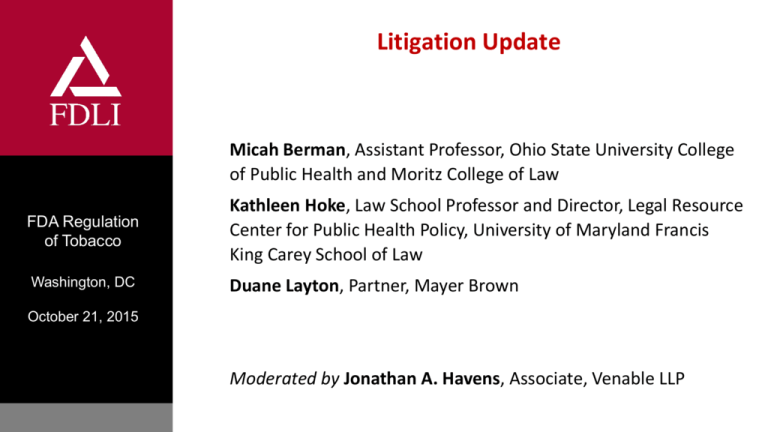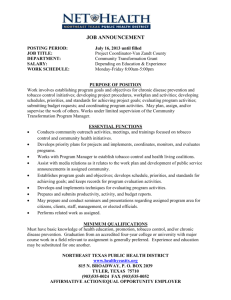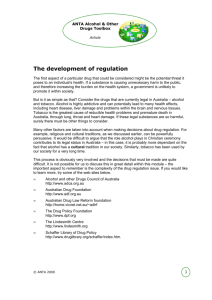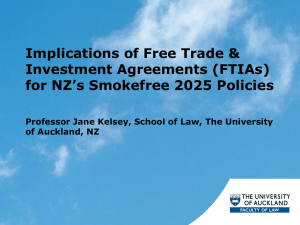Slides
advertisement

Litigation Update Micah Berman, Assistant Professor, Ohio State University College of Public Health and Moritz College of Law FDA Regulation of Tobacco Kathleen Hoke, Law School Professor and Director, Legal Resource Center for Public Health Policy, University of Maryland Francis King Carey School of Law Washington, DC Duane Layton, Partner, Mayer Brown October 21, 2015 Moderated by Jonathan A. Havens, Associate, Venable LLP Litigation Update: Tobacco Industry Challenges to State and Local Laws Kathleen Hoke Director, Legal Resource Center for Public Health Policy On behalf of: Tobacco Control Legal Consortium Tobacco Control Legal Consortium The Tobacco Control Legal Consortium (TCLC), a program of the Public Health Law Center, supports tobacco control policy change and the tobacco control movement throughout the United States. Presentation Overview • Flavored Products: – Focus on Chicago, flavored by NYC and Providence • Pricing Controls: – Dollars and cents from New York City to Providence • Electronic Cigarettes and E-Liquid: – Indiana e-liquid regulation and expansion of smokefree air laws Chicago’s Flavored Tobacco Restrictions a.k.a. “The Menthol Ban” The Ordinance—Chi., Ill., Code §4-64-098 • Enacted in December 2013 • Prohibits the sale of flavored tobacco product within 500 feet of any school • Flavored product is defined as imparting a “characterizing flavor” • Characterizing flavor is defined as a “distinguishable taste or aroma . . . including . . . menthol” Legal Challenge Independents Gas and Service Stations Ass’n v. Chicago, 2015WL4088743 (June 29, 2015) Plaintiffs alleged: • Preempted by FSPTCA • Unconstitutionally vague (14th Amend.) • Violation of vested rights/retroactive (state due process) Federal District Court for the Northern District of Illinois Decision City’s Motion to Dismiss Granted • Meaning no trial; decided on paper No appeal filed Most important claim for future regulation was FSPTCA preemption No Preemption by FSPTCA The FSPTCA “provides that states and their political subdivisions retain broad authority to regulate tobacco products” but “preempts local laws that regulate tobacco product standards” with the “exception . . . . for local laws that are related to sales, distribution, possession, access, advertising, or use of tobacco products.” Heavy Reliance on NYC Flavored Case (2nd Circuit 2013) U.S. Smokeless Tobacco Mfg. Co. LLC v. City of New York, 708 F.3d 428, 434 (2d Cir.2013): The FSPTCA “distinguishes between manufacturing and the retail sale of finished products.” Quoted extensively in the Chicago decision Take Away? Courts have been consistent in finding no FSPTCA preemption of restrictions on the sale of flavored tobacco products, finding these laws based on distribution and sales and not manufacturing. • Chicago (2015) • New York City (2013) • Providence (National Ass’n of Tobacco Outlets v. City of Providence, 731 F.3d 71 (1st Cir. 2013) New York City Pricing Controls The Ordinance—NYC Admin. Code §17-176.1 (relevant portions) Prohibits a retailer from: • Accepting a “price reduction instrument” (coupon) for tobacco products; • Providing multi-pack discounts; • Giving promotional items with purchase; • Selling for less than advertized price. Legal Challenge National Ass’n of Tobacco Outlets v. City of New York, 27 F.Supp.3d 415 (2014) Plaintiffs alleged: • Violation of First Amendment; • Preempted by FCLAA; • Preempted by NY state law. Federal District Court for the Southern District of New York City’s Motion for Summary Judgment Granted • Meaning no trial; decided on paper No appeal filed Most important claim was First Amendment challenge No First Amendment Violation “[P]rice regulations designed to discourage consumption of a potentially harmful product do not violate the First Amendment so long as they do not preclude the effected retailers' ability to provide truthful, nonmisleading information about the regulated product to consumers.” Heavy Reliance on Providence Pricing Case (1st Circuit 2013) • “In National Association of Tobacco Outlets [Providence case], the First Circuit applied this general principle to tobacco regulation and found that the prohibition of discounting practices, such as coupon redemption and multi-pack discounts, did not violate the First Amendment.” • “This court agrees.” Take Away on 1st Amendment An ordinance perceived by the court as regulating an economic transaction and not restricting communications about price on packaging, shelving, advertisements, or otherwise will survive scrutiny. FCLAA Preemption Claim Court explained that FCLAA preemption pertains only to health warnings on cigarette packages. States and localities are not preempted from time, place and manner restrictions. Take Away on FCLAA Preemption: Pricing restrictions do not invoke FCLAA preemption. Electronic Cigarettes Several state and local jurisdictions have included the use of electronic cigarettes in their clean indoor air laws. Challenges have failed. For example: NYC C.L.A.S.H. v. City of New York, 14 N.Y.S.3d 616 (N.Y. Sup. Ct. 2015)(did not violate single subject rule) E-Liquid Indiana Enrolled Act 1432 (2015), which becomes effective in 2016: • Requires e-liquid manufacturers to obtain permit ($1,000 for 5 yrs; $500 renewal); • Mandates 24-hour monitoring of storage rooms; • Exempts first generation electronic cigarettes (selfcontained). Legal Challenge Legato Vapors LLC v. Indiana, Case No. 1:15-cv-761 in the U.S. District Court for the Southern District of Indiana (filed May 12, 2015) Plaintiffs are liquid nicotine manufacturers with plants outside of Indiana and an Indiana vape shop Legal Challenge Plaintiffs allege: • Equal Protection Clause (14th Amend.) violation for treating them differently than closed system manufacturers/sellers; • Commerce Clause violation because impacts out-of-state manufacturers; Legal Challenge Plaintiffs allege: • Due Process Clause violation (14th Amend.): Because no rational basis for including e-liquid in definition of tobacco product; Because no rational basis for treating “open” e-liquid differently than contained system e-liquid Legal Challenge Status of Case: Preliminary stage Discovery will proceed Anticipate dispositive motions Contact Us us Kathleen Hoke khoke@law.umaryland.edu 410-706-1294 Maggie Mahoney Maggie.Mahoney@wmitchell.edu (651) 290-7514 www.publichealthlawcenter.org Federal Tobacco Litigation Update Micah Berman, J.D. Ohio State University College of Public Health & Moritz College of Law FDLI FDA Regulation of Tobacco October 21, 2015 • Lorillard v. FDA – TPSAC Challenge • Philip Morris v. FDA – Substantial Equivalence (SE) Guidance Challenge GLOBAL SIGNIFICANCE, LOCAL IMPACT Lawsuit #1: Lorillard v. FDA: TPSAC Challenge • Tobacco Products Scientific Advisory Committee • 9 voting members • 3 non-voting members (tobacco manufacturers, tobacco growers, small manufacturers) GLOBAL SIGNIFICANCE, LOCAL IMPACT Lorillard v. FDA: TPSAC Challenge GLOBAL SIGNIFICANCE, LOCAL IMPACT • Filed Feb. 25, 2011 (DDC) by Lorillard and RJ Reynolds • Claimed that 3 members of TPSAC had conflicts of interest in violation of FACA, APA, FDCA – Drs. Samet (chair), Benowitz & Henningfield • Any TPSAC report “must be disregarded and not relied upon for any purpose” GLOBAL SIGNIFICANCE, LOCAL IMPACT “Manufacturers of nicotinereplacement-therapy products and other smoking- cessation products . . . are in direct competition with tobaccoproduct manufacturers for the purchasing choices of adult smokers.” GLOBAL SIGNIFICANCE, LOCAL IMPACT District Court Opinion: July 21, 2014 (Leon, J.) • “[I]n the agency’s view, TPSAC members who performed consulting work for such drug companies had no financial conflict of interest. Please! This conclusions defies common sense.” • Past expert witness testimony does not create conflict, but future testimony does. GLOBAL SIGNIFICANCE, LOCAL IMPACT Appeal to D.C. Circuit • Dr. Samet & 3 other members resigned • Oral argument held on Oct. 7 (Millett, J.; Pillard, J.; Williams, S.J.) • Court requested supplemental briefing on ripeness and standing GLOBAL SIGNIFICANCE, LOCAL IMPACT Lawsuit #2: Substantial Equivalence (SE) Guidance Litigation Challenged “Guidance for Industry: Demonstrating the Substantial Equivalence of a New Tobacco Product: Responses to Frequently Asked Questions” (March 4, 2015) GLOBAL SIGNIFICANCE, LOCAL IMPACT Tobacco Control Act, Sec. 910 Substantially Equivalent = Same characteristics or different characteristics and applicant demonstrates that “product does not raise different questions of public health.” Characteristics = “materials, ingredients, design, composition, heating source, or other features of a tobacco product.” GLOBAL SIGNIFICANCE, LOCAL IMPACT GLOBAL SIGNIFICANCE, LOCAL IMPACT Current Status: - June 2: Suit voluntarily dismissed by plaintiffs - September 8: FDA issues new guidance document - Clarifies when SE submission is required, but does not change basic position - September 30: Suit refiled (Mehta, J.) GLOBAL SIGNIFICANCE, LOCAL IMPACT Micah Berman, J.D. • Berman.31@osu.edu • 614-688-1438 • @MicahLBerman GLOBAL SIGNIFICANCE, LOCAL IMPACT Tobacco “Plain Packaging”: A Legal Perspective The Food and Drug Law Institute Washington, D.C. Duane W. Layton Partner and Chair, Government & Global Trade Group Mayer Brown LLP 202-263-3811 dlayton@mayerbrown.com 21 October 2015 Australia Plain Packaging Tobacco • Australia first country to adopt plain (or standardized) packaging for a legal product • Cigarettes, cigars, and other tobacco products – Tobacco retail packaging • Ban design and figurative elements of trademarks and Gis • Uniform brown color • Other requirements (e.g., size, location, font) – Tobacco products • Cigarettes: no markings at all • Cigars: brand name, variant name, and country of origin in uniform style on a uniform band • Entry into force 1 December 2012 39 Australia Plain Packaging - Tobacco 40 Australia Plain Packaging - Tobacco 41 Australia Plain Packaging - Tobacco • Australia’s objective is to reduce tobacco consumption – By 2018 • Cut overall prevalence to 10 percent • Cut prevalence among aboriginal and Torres Strait population in half • Australia asserts that PP will achieve this objective by: – Reducing the appeal of tobacco products – Increasing the effectiveness of graphic health warnings – Reducing the ability of packaging to deceive consumers about the harmful effects of smoking 42 Reaction Within The WTO – Discussions In WTO Committees 43 Reaction Within The WTO – Discussions In WTO Committees • TBT Committee Meeting 10-11 November 2011 44 Reaction Within The WTO – Dispute Settlement Proceedings • Ukraine, Honduras, the Dominican Republic, Cuba, and Indonesia initially challenged Australia’s plain packaging requirements. Ukraine subsequently suspended. • One panel for all five challenges • One-quarter of WTO membership is involved as complainants, respondent, or third parties • Final decision expected next year • Pressure mounting in some countries to adopt plain packaging before WTO panel rules (e.g., U.K., Ireland) – What impact, if any, will this have on panel and the DS system? 45 Reaction Within The WTO – Dispute Settlement Proceedings • Two sets of claims against plain packaging – Art. 20 TRIPS and Art. 2.2 TBT • Does plain packaging “unjustifiably” encumber TMs? • Is plain packaging “more trade restrictive than necessary”? – Panel will likely focus on, inter alia, efficacy of plain packaging and reasonably available alternatives – To what extent will panel weigh and consider expert opinions? – Art. 2.1, 15, 16, 22.2, and 24.3 TRIPS • Apart from its efficacy and necessity, is plain packaging consistent with Australia’s treaty obligations under TRIPS? – Panel will likely focus on, inter alia, right to use TMs and impact of plain packaging on right to exclude confusing uses 46 Reaction Within The WTO – Dispute Settlement Proceedings • WTO vs. WHO – Australia claims its PP law implements “certain obligations [it] has as a party to the Convention on Tobacco Control” (the FCTC). See § 3(1)(b) of PP Act – Yet in public statements Australia acknowledges that nothing in the FCTC or the official “Guidelines” to the FCTC mandates plain packaging – at least in the form embraced by Australia – Rather, these instruments recommend that Parties “should consider adopting measures” that restrict or prohibit the use of logos, brand images, etc. (emphasis added) – And even if this language was mandatory and not horatory, Article 11 of the FCTC actually provides that packaging and labeling is permitted, and in fact may be used to “promote” a tobacco product, as long as it is not “false, misleading, deceptive or likely to create an erroneous impression” 47 Reaction Within the WTO – Dispute Settlement Proceedings • WTO vs. WHO – The WTO agreements can and should be interpreted in a manner supportive of a Members’ right to protect public health (see, e.g., TBT 2.2 and TRIPS 8.1) – However, Members must do so in a manner consistent with their WTO and other treaty obligations – Indeed, that is precisely what TRIPS 8.1 says – The WTO panel and ultimately (I suspect) the Appellate Body will have to decide whether the version of plain packaging adopted by Australia is consistent with the WTO agreements 48 Relevance Of WTO Dispute To Other Countries And Products • Australia WTO case is not just about Australia – Other countries are introducing or contemplating the adoption of plain packaging • Australia WTO case is not just about tobacco – Case could have broad impact on IP protections for other products considered harmful 49 Is Tobacco Plain Packaging The “Slippery Slope”? What Next? 50 Is Tobacco Plain Packaging The “Slippery Slope”? What Next? 51 Is Tobacco Plain Packaging The “Slippery Slope”? What Next? 52 Is Tobacco Plain Packaging The “Slippery Slope”? What Next? 53 Questions? Duane W. Layton Partner and Chair, Government & Global Trade Group Mayer Brown LLP (202) 263-3811 dlayton@mayerbrown.com 54






